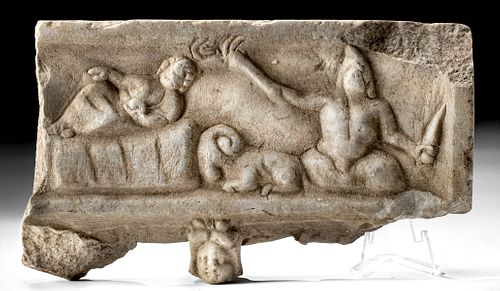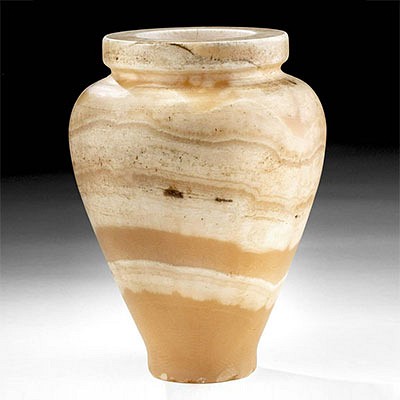Roman Marble Relief Panel with Birth of Mithras
Lot 22
About Seller
Artemis Fine Arts
686 S Taylor Ave, Ste 106
Louisville, CO 80027
United States
Selling antiquities, ancient and ethnographic art online since 1993, Artemis Gallery specializes in Classical Antiquities (Egyptian, Greek, Roman, Near Eastern), Asian, Pre-Columbian, African / Tribal / Oceanographic art. Our extensive inventory includes pottery, stone, metal, wood, glass and textil...Read more
Estimate:
$3,000 - $4,500
Absentee vs Live bid
Two ways to bid:
- Leave a max absentee bid and the platform will bid on your behalf up to your maximum bid during the live auction.
- Bid live during the auction and your bids will be submitted real-time to the auctioneer.
Bid Increments
| Price | Bid Increment |
|---|---|
| $0 | $25 |
| $300 | $50 |
| $1,000 | $100 |
| $2,000 | $250 |
| $5,000 | $500 |
| $10,000 | $1,000 |
| $20,000 | $2,500 |
| $50,000 | $5,000 |
| $100,000 | $10,000 |
| $200,000 | $20,000 |
About Auction
By Artemis Fine Arts
Dec 17, 2020
Set Reminder
2020-12-17 10:00:00
2020-12-17 10:00:00
America/New_York
Bidsquare
Bidsquare : VARIETY SALE | Antiquities & Ethnographic Art
https://www.bidsquare.com/auctions/artemis-gallery/variety-sale-antiquities-ethnographic-art-6207
Featuring classical antiquities, ancient and ethnographic art from cultures encompassing the globe. Egyptian, Greek, Roman, Etruscan, Near Eastern, Asian, Pre-Columbian, Native American, African / Tribal, Oceanic, Spanish Colonial, Russian, Fossils, Fine Art, more! Artemis Fine Arts info@artemisfinearts.com
Featuring classical antiquities, ancient and ethnographic art from cultures encompassing the globe. Egyptian, Greek, Roman, Etruscan, Near Eastern, Asian, Pre-Columbian, Native American, African / Tribal, Oceanic, Spanish Colonial, Russian, Fossils, Fine Art, more! Artemis Fine Arts info@artemisfinearts.com
- Lot Description
Rome, Imperial, ca. 1st to 4th century. A stunning hand-carved marble relief panel depicting the birth of the Roman god Mithras. Shown from the torso up and wearing a Phrygian cap, the cult deity emerges from the "generative rock" from which he was born as a fully formed young man. His extended right arm holds up a torch, symbolic of the fire or light hidden deep in the rock that birthed him, and a knife in his left, an allusion to his future slaying of a sacred bull. To the left, a recumbent god lays on a bed with his upper body propped up by his left arm, which holds a patera (libation bowl), while his right arm stretches outward to rest on his bent knee. The similarity of this pose to that of a Roman river god suggests that this character is Oceanus, the Titan water god and father of the river gods, who is a frequent attendee in depictions of Mithras' birth. Between them lays an ibex, one of many animals often shown at Mithras' nativity and an allusion to the shepherds who are also occasionally present. A simple yet elegant border frames the scene on 3 sides with a small head featured below the bottom border, reminiscent of a caryatid. A remarkable relief from the Roman mystery cult of Mithraism. Size: 8.5" L x 1.5" W x 5" H (21.6 cm x 3.8 cm x 12.7 cm)
Mithraism (also known as the Mithraic mysteries) was a Roman cult religion that focused on the god Mithras. Members of Mithraism would meet underground in temples called mithraea (singular mithraeum); many of which survive today and contain impressive reliefs, sculptures, and frescoes that act as our only source of information about the curious cult. Popular among the Roman army from the 1st to 4th centuries, Mithraic symbolism, like this example, can be found throughout the most expansive periods of the Empire from Roman Britain (a temple to Mithras can still be seen in the modern City of London) to its eastern coasts in the ancient-places-turned-colonies of Thracia and Dacia to Roman Syria, and even Roman Africa and Numidia. These mythraea often include four main illustrations: Mithras' birth from a rock, his slaying of a sacred bull, the celebratory banquet of the bull's slaying, and a lion-headed figure. As Christianity began to gain popularity and influence, Mithraism became a competing religion and more importance was placed on Mithras' miraculous birth. The iconography around the birth changed to include shepherds and farm animals, like the ram seen here, making it seem as though Mithras was born in a barn and thus likening him to Christ.
Provenance: ex Estate of Eldert Bontekoe, Pegasi Numismatics, Ann Arbor, Michigan USA acquired before 2000
All items legal to buy/sell under U.S. Statute covering cultural patrimony Code 2600, CHAPTER 14, and are guaranteed to be as described or your money back.
A Certificate of Authenticity will accompany all winning bids.
We ship worldwide and handle all shipping in-house for your convenience.
#160085Fragment of a larger piece. Missing part of upper right corner with some minute nicks/chips and abrasions on periphery. Light softening of details with some scratches to relief. Otherwise, excellent.Condition
- Shipping Info
-
All shipping is handled in-house for your convenience. Your invoice from Artemis Gallery will include shipping calculation instructions. If in doubt, please inquire BEFORE bidding for estimated shipping costs for individual items.
-
- Buyer's Premium



 EUR
EUR CAD
CAD AUD
AUD GBP
GBP MXN
MXN HKD
HKD CNY
CNY MYR
MYR SEK
SEK SGD
SGD CHF
CHF THB
THB














